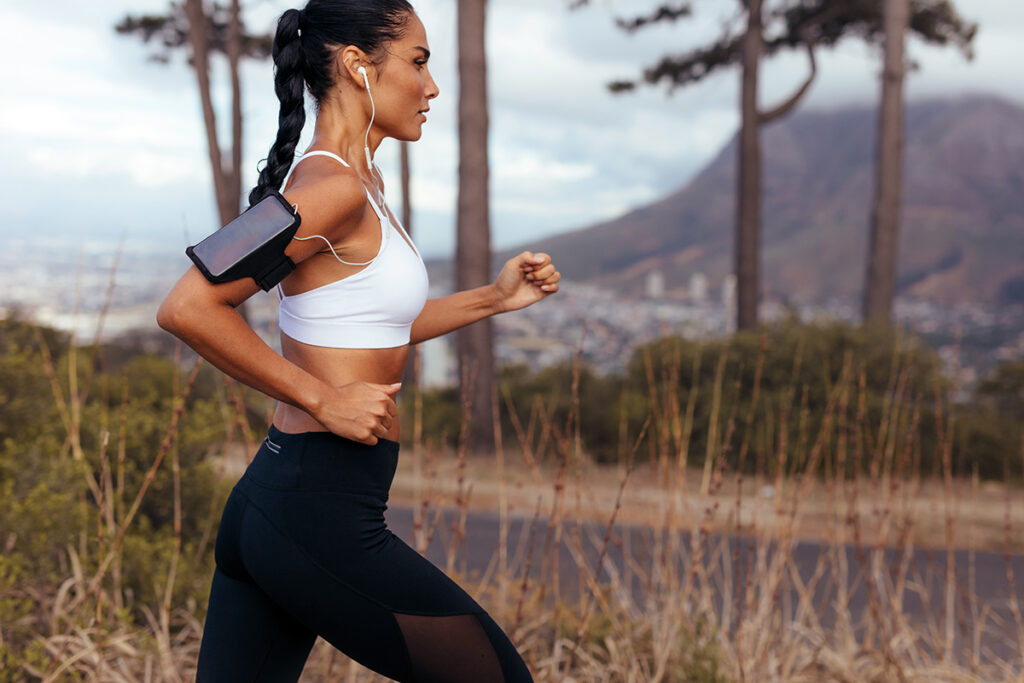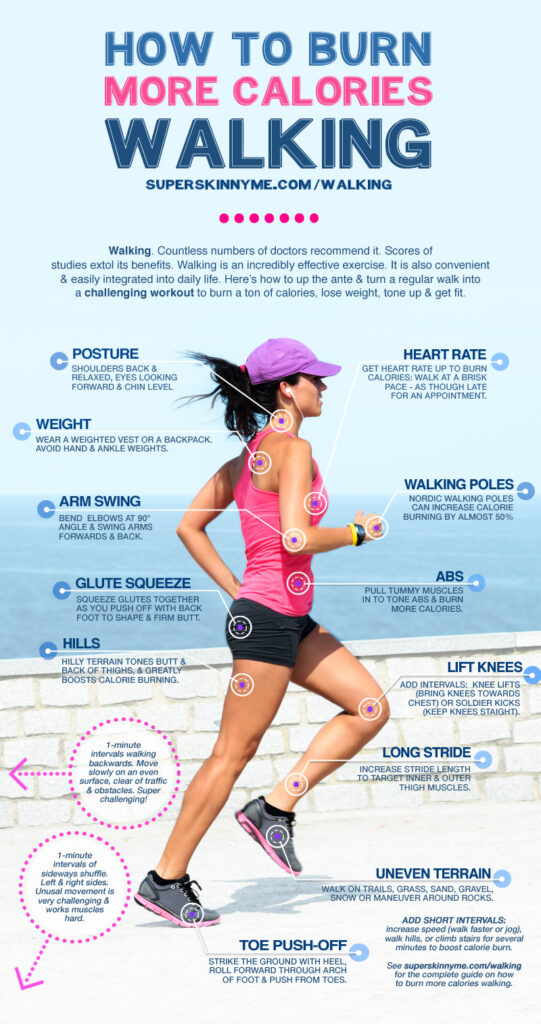Walking is an easy, accessible form of exercise that requires neither a bunch of expensive equipment nor a special set of skills. It doesn’t call for a high level of fitness or an elaborate workout space. And it comes with a plethora of benefits.
According to research walking may help to reduce the risk of chronic diseases, such as high blood pressure, high cholesterol, diabetes, and heart disease.123 It may also boost immune function and reduce the risk of developing acute respiratory infections such as cold and flu.4 Walking regularly is associated with increased longevity, and studies show it may slow down age-related decline in memory.56 Walking may also improve mood, especially when walking in nature.78
All that, plus the fact that walking strengthens muscles, boosts endurance and stamina, and burns calories. So how many calories can you burn walking?
Calories Burned Walking
How many calories you burn walking depends on how far you walk and your bodyweight. You burn about 100 calories per mile if you weigh 180lbs, and a one-hour walk will burn between 300 and 400 calories when walking at a brisk pace.
Using that rule of thumb, you can easily work out how many calories you burn walking. To make things even easier, we’ve put together some charts to help you determine how many calories you’ll burn.
Calories Burned Walking per Mile
The chart below shows how many calories you burn walking per mile for your bodyweight, at a pace of 4 mph. The further you walk, the more calories you burn.
| Distance | 120 lbs | 140 lbs | 160 lbs | 180 lbs | 200 lbs | 220 lbs |
|---|---|---|---|---|---|---|
| Mile 1 | 68 | 80 | 91 | 102 | 114 | 125 |
| Mile 2 | 136 | 159 | 182 | 205 | 227 | 250 |
| Mile 3 | 205 | 239 | 273 | 307 | 341 | 375 |
| Mile 4 | 273 | 318 | 364 | 409 | 454 | 500 |
| Mile 5 | 341 | 398 | 455 | 512 | 568 | 625 |
| Mile 6 | 409 | 477 | 545 | 614 | 682 | 750 |
| Mile 7 | 477 | 557 | 636 | 716 | 795 | 875 |
| Mile 8 | 546 | 636 | 727 | 818 | 909 | 1000 |
| Mile 9 | 614 | 716 | 818 | 921 | 1022 | 1125 |
| Mile 10 | 682 | 795 | 909 | 1023 | 1136 | 1250 |
The above chart shows how many calories you burn per mile walking on flat, firm ground. However, walking uphill burns about 60% more calories per mile than walking on the flat. So a 140-pound person would burn an extra 40 calories per mile compared to walking on a level surface.9
Calories Burned Walking per Hour
Walking pace is important because the faster you walk, the more miles you can cover, which means you burn more calories.
Just to underscore how effective it is to pick your pace, a 150 lbs person walking for 1 hour at a leisurely pace of 2.0 mph burns roughly 170 calories. Increase that walking pace to 3.5 mph (brisk walk), they’ll burn about 260 calories. At a very brisk of 4.0 mph, it would be almost 340 calories. You can literally double your calorie burn, just by walking faster.
The chart below shows the calories burned walking for 1 hour according to walking speed and bodyweight.
| Walking Speed | 120 lbs | 140 lbs | 160 lbs | 180 lbs | 200 lbs | 220 lbs |
|---|---|---|---|---|---|---|
| 2.0 mph (30 min/mile) | 136 | 158 | 182 | 204 | 226 | 250 |
| 2.5 mph (24 min/mile) | 164 | 190 | 218 | 244 | 272 | 300 |
| 3.0 mph (20 min/mile) | 180 | 210 | 240 | 270 | 300 | 330 |
| 3.5 mph (17 min/mile) | 206 | 242 | 276 | 310 | 344 | 380 |
| 4.0 mph (15 min/mile) | 272 | 318 | 362 | 408 | 454 | 498 |
| 4.5 mph (13min/mile) | 344 | 400 | 458 | 514 | 572 | 628 |
| 5.0 mph (12 min/mile) | 436 | 508 | 580 | 654 | 726 | 798 |
An average person walks at a speed of about 2.5 to 3 miles an hour (about 20 minutes a mile).10 To lose weight and get fit aim to walk at a brisk pace, which is generally about 3.5 to 4 miles an hour (15 minutes a mile). Increasing your pace from 3 mph to 4 mph means you’ll burn about one third extra calories.
Calories Burned Walking Calculator
Calculate how many calories you burn walking with this easy calculator. Simply plug in your weight, select your walking pace, and add the duration of your walking workout.
Walking is a great way to lose weight. And it’s easy to incorporate walking into your schedule by adding mini-workouts into your day. Using a pedometer can also help you keep track and encourage you to take more steps.
Q&A
Walking for Weight Loss
Here are some tips to help you lose weight, get fit, and improve your health by walking.
How fast should you walk? To lose weight walking, aim to walk at a brisk pace. A brisk pace should feel like you’re walking with purpose. Start walking at a pace as though you are on your way to an appointment with little time to spare. If that pace seems too easy, try walking at a pace as though you were several minutes late for an appointment. You should be walking faster than usual and be slightly out of breath, but still able to talk in short sentences.
What happens when you lose weight? People who weigh less burn less calories walking per mile. Therefore, when you lose weight you burn fewer calories doing the same activity. So if you want to keep burning a similar amount of calories, you need to make your walking workouts more challenging.1415
How should you progress? To make your workout more challenging you can walk further at the same pace, so you’ll spend more time walking. Or you can walk faster and cover more distance in the same time. For example, if your current walking route takes 30-minutes to complete, try and cover a slightly longer distance in the same time. Maintain your new speed or distance for a week or two and then try to slightly increase it again.
What are the benefits? Walking faster doesn’t just help you burn more calories, but can also increase the health benefits of walking. Research suggests that walking at a brisk pace lowers the risk of heart disease, cancer, dementia and death more than walking a similar distance at a slower pace.16
Next steps. Once you can easily walk at a brisk pace of about 4 mph for 30 minutes, you can try gradually incorporating 30-second bouts of slow jogging (at a pace not much faster than a fast walk) or try this walk-run plan.






My measurements are 36 31 39 and all the calculators say I’m a pear but one of the main features is a small bust but I’m a D cup and my closest measurements on this website are 36 30 38 In the hourglass section. So what am I?